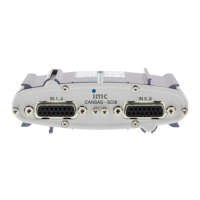232 Measurement Technique
imc CANSAS Users Manual - Doc. Version 1.9 - 05.12.2014© 2014 imc Meßsysteme GmbH
5.8 TEDS
5.8.1 TEDS: Plug & Measure functionality for sensors
When connecting classic sensors such as strain gauges, thermometers or power meters to measurement
devices, the user requires knowledge of sampling rates, scaling factors, units, etc. in order to be able to
obtain the desired measurement results.
An additional problem is posed by the task of taking measurements of large-scale installations with high
channel counts. In settings where there can be up to hundreds of measurement locations, for instance on
board trains or planes, or for more complex measurements of road vehicles, extra difficulties can arise
from the increased likelihood of incorrect connection of sensors to channels, or of incorrect device
settings. Getting sensors mixed up is, unfortunately, a familiar situation.
For all these reasons, imc is now introducing an electronic data sheet which can be retrofitted to all
commercially available sensors and which eliminates the problems spelled out above.
5.8.1.1 How can measurement be simplified for the user?
Complex, multifunctional user interface for making device settings are needed only in exceptional
circumstances. The necessary parameters for making the measurement device's settings are recorded in
"electronic spec sheets" linked to the sensors to be connected. The measurement device is able to both
read and process these data, which are stored in so-called Transducer Electronic Data Sheets (TEDS). The
sensor settings are made by the company's own measurement specialists.
This makes it possible for the measurement devices to be operated reliably by personnel less qualified in
measurement engineering.
Ideally, the following conditions are provided:
All data relevant to measuring with a particular sensor (e.g. the sensor's preferred sampling rate)
are contained in the electronic spec sheet linked to it,
all sensors already present can be equipped with such an electronic data sheet,
the user can connect the sensor at any input of an all-purpose measurement device,
the user can ready the measurement system for operation at a single mouse-click, without needing
skills in using a complex software interface, much less in actual programming,
sensors can be interchanged without causing the entire measurement system, e.g., as a test station
component, to require re-calibration.
5.8.1.2 Steps Towards Achieving "Plug & Measure" Functionality
In the draft for the standard IEEE P1451 /1/, the standardization committee sets out the definition for a
so-called "smart sensor". It's based on a TEDS which contains all information about the sensor available.
This information can be used once the sensor has been connected to the measurement device. P1451.4
defines a so-called "mixed-mode interface", according to Class 1 both the sensor's measurement signal
and TEDS-data can be carried on the same line.
A "Mixed Mode Interface" sends/ receives TEDS data and receives analog signals.
Class I interfaces are designed for constant-current-fed piezo-electrical sensors and use these
sensors' quasi-standard (integrated electronic piezoelectric [IEPE] transducer).
Class II interfaces are designed for bridges and other sensors.

